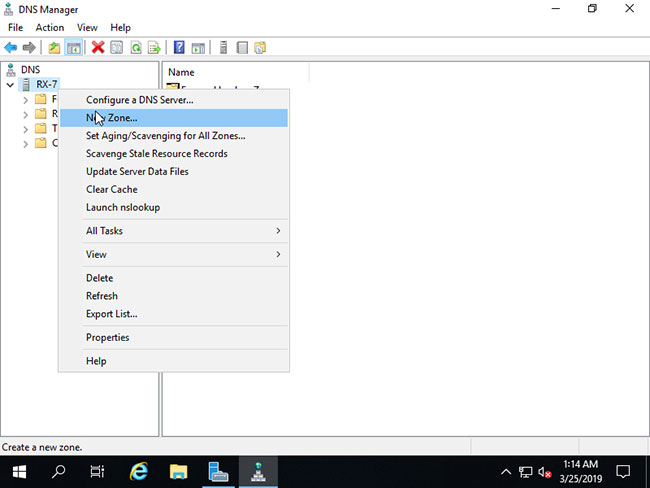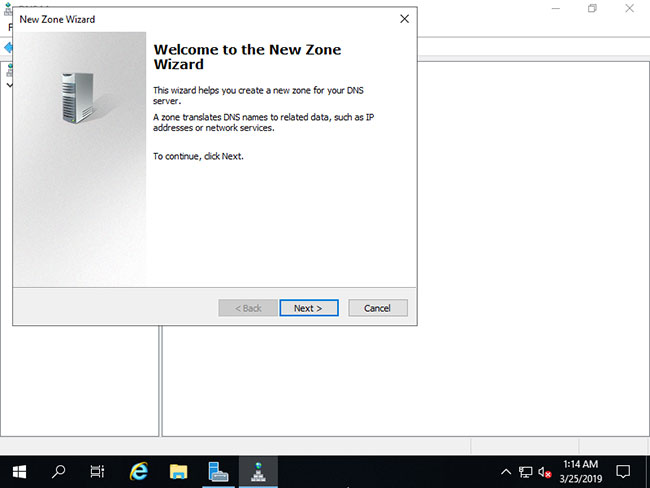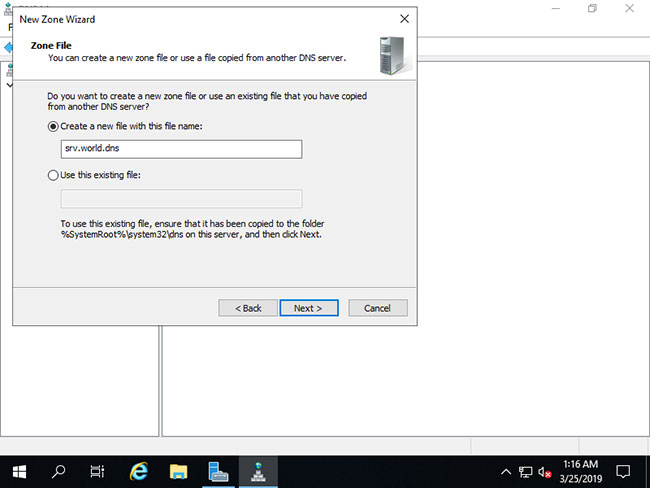How to install DNS Server on Windows Server 2019
In today's article, TipsMake will explain how to install DNS Server on Windows Server 2019 and then perform other additional configuration. Before proceeding, make sure that you have configured a static IP address on your server.
Install DNS Server on Windows Server 2019
Configure DNS Server to provide hostname resolution or IP address!
On the CUI settings, set up as follows:
Step 1. Run PowerShell as admin and enter the following code to install DNS Server.
Windows PowerShell Copyright (C) Microsoft Corporation. All rights reserved. # install DNS with admin tools PS C:UsersAdministrator> Install-WindowsFeature DNS -IncludeManagementTools Success Restart Needed Exit Code Feature Result ------- -------------- --------- -------------- True Yes SuccessRest. {DNS Server, . WARNING: You must restart this server to finish the installation process. # restart computer to apply changes PS C:UsersAdministrator> Restart-Computer -Force On the GUI settings, set up as follows:
Step 2. Run Server Manager and click Add roles and features .

Step 3. Click the Next button .

Step 4. Select Role-based or feature-based installation .

Step 5. Select a Host for which you want to add services.

Step 6. Check the box DNS Server .

Step 7. Additional features required to add DNS Server. Click the Add Features button and then click Next .

Step 8. Click the Next button .

Step 9. Click the Next button .

Step 10. Click the Install button .

Step 11. After finishing the installation process, click the Close button .

Add the Forward Lookup Zone to the DNS Server
Step 1. Run Powershell as administrator and configure it as follows.
The following example adds a Forward Lookup Zone with the Zone-Name setting "srv.world" , Zone-File "srv.world.dns" . In general, give your domain name or part of your domain name to Zone-Name.
Windows PowerShell Copyright (C) Microsoft Corporation. All rights reserved. PS C:UsersAdministrator> Add-DnsServerPrimaryZone -Name "srv.world" -ZoneFile "srv.world.dns" -DynamicUpdate None -PassThru ZoneName ZoneType IsAutoCreated IsDsIntegrated IsReverseLookupZone IsSigned -------- -------- ------------- -------------- ------------------- -------- srv.world Primary False False False False PS C:UsersAdministrator> Get-DnsServerZone # [srv.world] has been added ZoneName ZoneType IsAutoCreated IsDsIntegrated IsReverseLookupZone IsSigned -------- -------- ------------- -------------- ------------------- -------- 0.in-addr.arpa Primary True False True False 127.in-addr.arpa Primary True False True False 255.in-addr.arpa Primary True False True False srv.world Primary False False False False TrustAnchors Primary False False False False # if remove it, run like follows PS C:UsersAdministrator> Remove-DnsServerZone "srv.world" -PassThru Confirm [Y] Yes [N] No [S] Suspend [?] Help (default is "Y"): Y ZoneName ZoneType IsAutoCreated IsDsIntegrated IsReverseLookupZone IsSigned -------- -------- ------------- -------------- ------------------- -------- srv.world Primary False False False FalseStep 2. Run Server Manager and select Tools> DNS .

Step 3. Select Hostname in the left panel and right click on Hostname to bring up the menu and select New Zone .

Step 4. Click the Next button .

Step 5. Check the Primary zone box and click the Next button .

Step 6. Check the Forward Lookup Zone box and click the Next button .

Step 7. Enter a name in the Zone name field . As described on the screenshot below, please give the domain name or part of the domain name to this Zone name.

Step 8. Set zone-file-name and click Next button . You can keep the default name for zone-file-name.

Step 9. Click the Next button and keep the default options.

Step 10. Click the Finish button .

Step 11. A new zone has been created in the Forward Lookup Zone.

You should read it
- How to set up your own Git server on Linux
- Instructions for installing SQL Server 2019
- SQL Server 2019 - Microsoft Relational Database Management System
- Download Windows Server 2019 and discover new features
- Introducing Exchange Server 2019, how to install Exchange Server 2019
- 7 great ideas using Raspberry Pi as a server
- How to install and use IIS on Windows Server 2019
- Microsoft added recovery, backup, security for Windows Server 2019
May be interested
- How to install Nextcloud server on Windows 10
 nextcloud is a perfect replacement for owncloud cloud storage software. it has both an open source community version and a paid business version.
nextcloud is a perfect replacement for owncloud cloud storage software. it has both an open source community version and a paid business version. - Install Role, configure role on Windows Server 2012
 like previous versions, windows server 2012 has many associated roles. roles and features are tools you need to install or enable to complete your it administration tasks, if you don't install them, you can't do anything. in this article, we will learn how to install and configure the most important roles.
like previous versions, windows server 2012 has many associated roles. roles and features are tools you need to install or enable to complete your it administration tasks, if you don't install them, you can't do anything. in this article, we will learn how to install and configure the most important roles. - 4 basic difference between Windows Server and Windows Desktop
 windows server is the operating system for servers, servers, so it will have differences compared to the windows desktop version we still see everyday. keep these in mind when you need to choose to install windows server or windows desktop. they are also important when you need to restore, repair installation.
windows server is the operating system for servers, servers, so it will have differences compared to the windows desktop version we still see everyday. keep these in mind when you need to choose to install windows server or windows desktop. they are also important when you need to restore, repair installation. - Create VPN Server on Windows 8
 no need to install any additional applications, you can easily 'turn' your computer into a vpn server if you're using windows 8. in this way, you can share data from the computer. as a simple lan system in the form of remote access. & a
no need to install any additional applications, you can easily 'turn' your computer into a vpn server if you're using windows 8. in this way, you can share data from the computer. as a simple lan system in the form of remote access. & a - How to install Hyper-V in Windows Server 2012
 virtualization is one of the most important technological features. microsoft has invested in developing this feature and called it hyper-v.
virtualization is one of the most important technological features. microsoft has invested in developing this feature and called it hyper-v. - How to install Owncloud server on Windows 10 (WSL)
 owncloud server is an open source cloud storage solution with multimedia playback and file sharing capabilities.
owncloud server is an open source cloud storage solution with multimedia playback and file sharing capabilities. - Install and configure Windows Home Server
 today we will introduce you to windows home server and show you how to install and configure it with other computers on your network.
today we will introduce you to windows home server and show you how to install and configure it with other computers on your network. - Install Hyper-V Virtualization on Windows Server 2008 R2
 in the following article, we will introduce and guide you a few basic steps to install and deploy the technology platform that supports virtualization of hyper-v on windows server 2008 r2.
in the following article, we will introduce and guide you a few basic steps to install and deploy the technology platform that supports virtualization of hyper-v on windows server 2008 r2. - How to install and open File Server Resource Manager in Windows Server 2012
 file server resource manager is a feature that helps system administrators manage shared folders, in terms of setting limits or expanding file restrictions.
file server resource manager is a feature that helps system administrators manage shared folders, in terms of setting limits or expanding file restrictions. - How to install Active Directory on Windows Server 2019
 one of the best features that makes windows server shine in the enterprise arena is the active directory. this single sign-on tool integrates seamlessly and easily with most microsoft products making managing users pretty easy and enjoyable.
one of the best features that makes windows server shine in the enterprise arena is the active directory. this single sign-on tool integrates seamlessly and easily with most microsoft products making managing users pretty easy and enjoyable.










 Set up Remote Desktop on Windows Server 2019
Set up Remote Desktop on Windows Server 2019 Introducing Exchange Server 2019, how to install Exchange Server 2019
Introducing Exchange Server 2019, how to install Exchange Server 2019 Configure SSH Server and SSH Client on Windows Server 2019
Configure SSH Server and SSH Client on Windows Server 2019 How to configure NTP Server and NTP Client in Windows Server 2019
How to configure NTP Server and NTP Client in Windows Server 2019 How to initial setup Windows Server 2019
How to initial setup Windows Server 2019 4 best tips for server protection
4 best tips for server protection